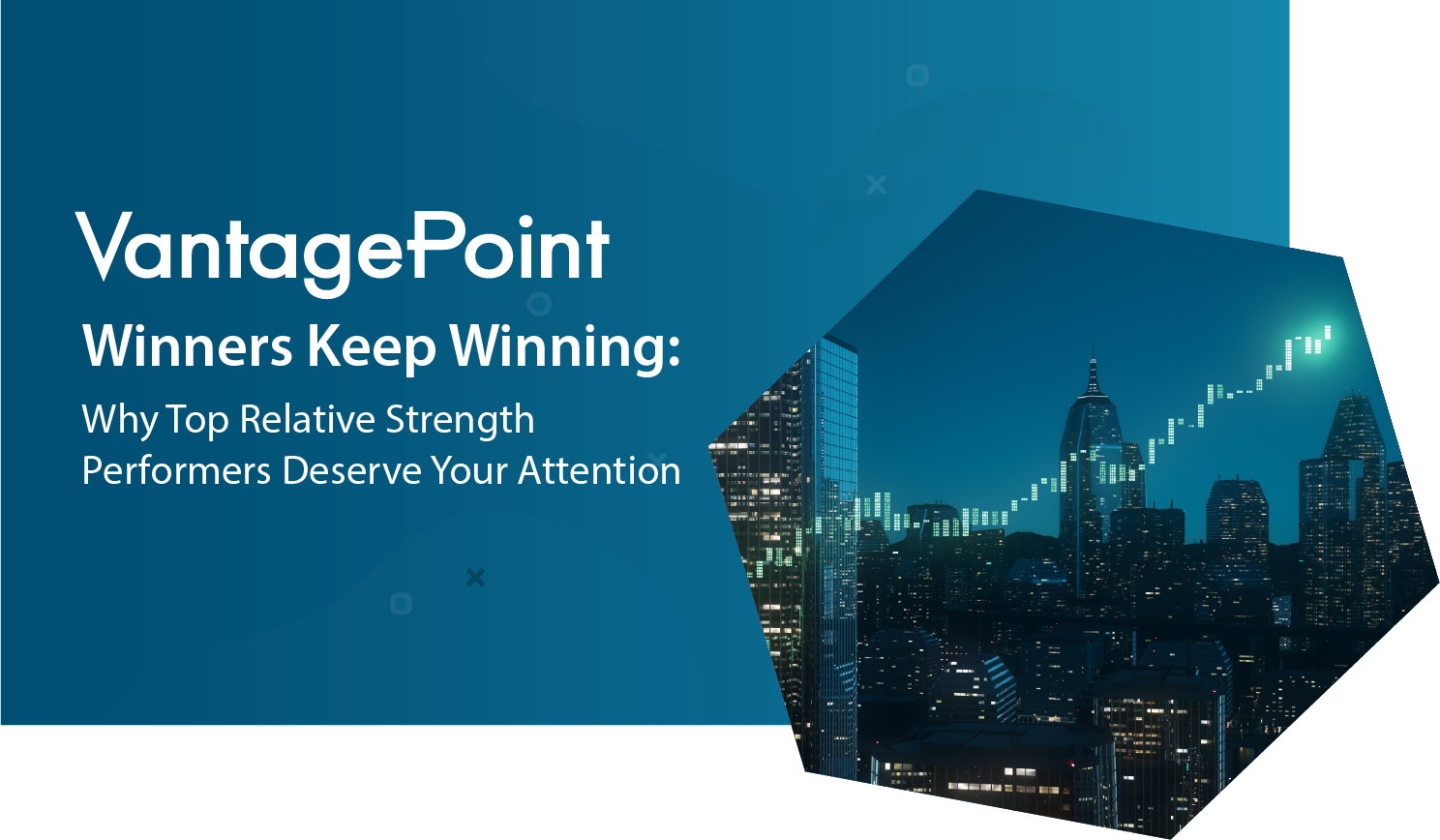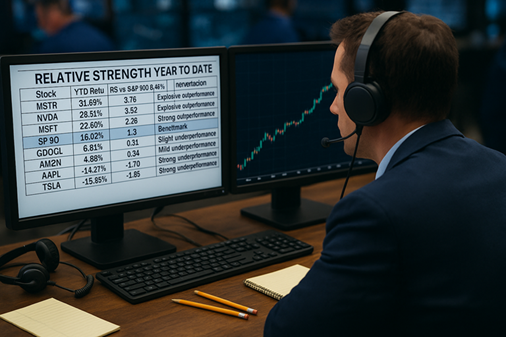
Wall Street has always had a thing for shiny objects. In the 1950s and 1960s, it was electronics — the original “growth” industry. Investors couldn’t get enough of anything that sounded remotely like the future. Companies began branding themselves accordingly, slapping the letter “X” into their names or tickers, not for science, but for sizzle. It worked. Money poured in. Never mind if the business model was murky — if it sounded high-tech, it sold. It was an early lesson in how perception can drive capital allocation more powerfully than fundamentals.
Then came the late 1960s and early 1970s, ushering in what became known as the Nifty Fifty — a group of blue-chip growth stocks that were considered “one-decision” investments. Companies like IBM, Polaroid, and McDonald’s were anointed as permanent portfolio residents. The thesis? Buy them and forget them. But as interest rates surged and inflation crept in, valuations that once seemed bulletproof turned brittle. Many Nifty Fifty darlings collapsed by 60%, 70%, even 90% during the 1973 – 1974 bear market. The lesson? Even the bluest of blue chips can bleed if you don’t respect the cycle.
You know how this goes. It’s not just about companies doing well — it’s about everyone thinking they’ll keep doing well forever. That’s how we get bubbles. Dot-com? A click and a promise. Subprime? A mortgage and a shrug. Non-Bitcoin crypto? Magic money and laser eyes. These trends weren’t fake — they were just turbocharged by belief. And belief is fragile. If you bought early and sold before reality showed up with a baseball bat, you made a fortune. But most people? They ride the wave until it breaks. That’s the catch: getting rich is easy. Staying rich? That takes a sell discipline.
Fast forward to today, and we’re looking at the modern-day equivalents of the Nifty Fifty: the Magnificent 7 — Apple, Microsoft, Alphabet, Amazon, Nvidia, Meta, and Tesla. These aren’t just market leaders. They are the market.
Their collective weight in the S&P 500 is so massive that when these stocks rise, indexes rise — and when they falter, everything else shakes. Their earnings, margins, and forward guidance don’t just affect their own stock — they influence bond yields, sector rotations, and algorithmic signals globally.
Everybody’s heard of the Magnificent 7 — AAPL, MSFT, GOOGL, AMZN, META, NVDA, TSLA — the rockstars of the modern stock market. Most folks treat these names like they’re sacred relics handed down from the financial gods. And hey, looking at their cumulative returns since IPO, who could blame ‘em? These stocks didn’t just beat the market — they redefined what winning looks like. They’ve printed fortunes, built empires, and made average Joes feel like Warren Buffett… for a while.
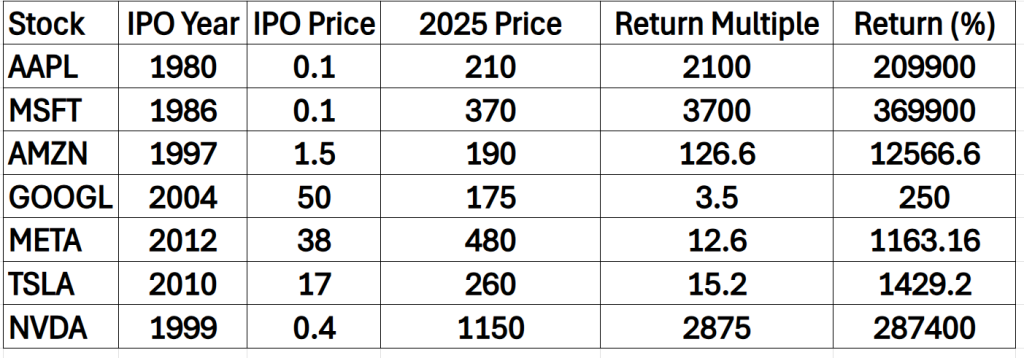
But here’s the rub most investors miss — the Mag7 aren’t just stocks. They’re larger signals. Think of them as the market’s vital signs. When they’re sprinting, the S&P 500 and broader indexes start flexing like they’ve been hitting the gym. When they stumble? Buckle up, because the whole market starts coughing up blood. That’s not opinion — that’s observable fact, played out time and again. Just look at any pullback over the last five years and track who started bleeding first. Spoiler alert: it wasn’t the small caps.
Now, here’s where the rubber meets the road… Traders worth their salt don’t worship the Mag7. They watch them like hawks. Because the truth is, when one of these monsters starts underperforming the index, it’s not just a bad week — it’s a siren. It’s a crack in the armor. And if two or three of them lag? That’s a code red, my friend. That’s the moment when you stop throwing darts and start tightening stops. Because history shows, when these titans catch a cold, the rest of the market gets pneumonia.
So, you want an edge? Watch the Mag7. Watch their relative strength to the S&P 500. Because that’s where the early trouble shows up. And the earlier you spot trouble in paradise, the sooner you get to the lifeboat — before the herd starts screaming “Titanic!”
You want to be a smart trader, not a hopeful investor. Big difference.
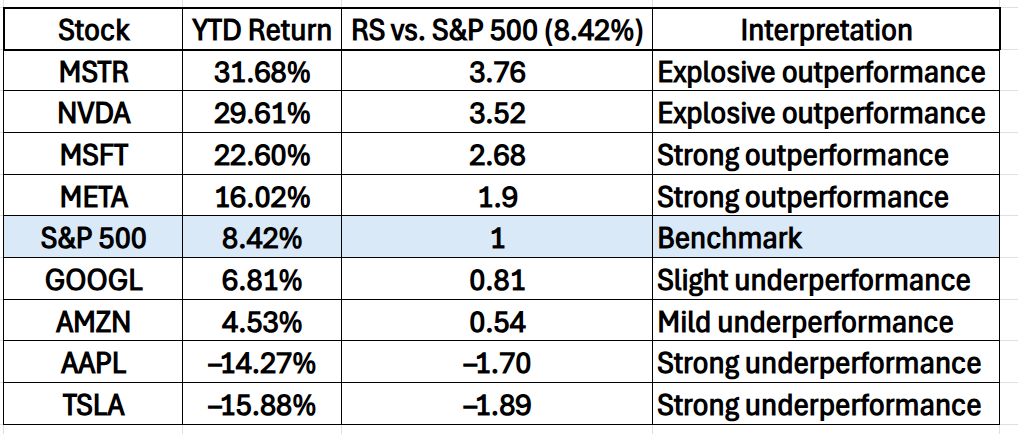
🔎 What Does This Mean?
- An RS value of 1.0 means equal performance.
- Greater than 1.0 means the stock is outperforming the index.
- Less than 1.0 means the stocks is underperforming.
- A negative value like –1.70 shows that AAPL is underperforming significantly and moving in the opposite direction of the index.
In every bull market, there are clues hidden in plain sight for those savvy enough to see them. The chart above is one of those clues. Year to date, the S&P 500 is up a respectable 8.42%, but here’s where it gets interesting — four of the Magnificent 7 stocks (GOOGL, AMZN, AAPL, and TSLA) are actually underperforming that benchmark. That’s not just a crack in the armor — it’s a flashing yellow light. Historically, when the leaders lag, the entire market becomes vulnerable. This isn’t just about red and green numbers; this is about reading the pulse of Wall Street’s core drivers.
Now look at the other side of the ledger. NVDA, MSFT, and META are absolutely crushing it — leading the charge with strong, even explosive, outperformance. And just as compelling is the addition of MSTR. While not technically part of the Mag7, I’ve included MicroStrategy because it’s become a de facto Bitcoin proxy, trading with massive volume and behaving like a high-octane tech leader. With a 31.68% return year-to-date and a relative strength score that dwarfs the index, it’s the kind of breakout performer that can give smart traders an extra edge. Bottom line: this chart isn’t just a scoreboard — it’s a radar. And right now, it’s showing both opportunity and early signs of trouble.
And that’s why traders monitor the Mag 7 like hawks. Not because they’re chasing fads, but because these names act as structural beams holding up the broader market. When one sneezes, the others may wobble. But when more than one falters? The entire S&P catches pneumonia. Traders learned that in 2022, when a tech correction spiraled into a market-wide selloff. So, while A.I. and cloud growth remain dominant themes, the experienced trader isn’t just bullish — they’re strategically alert. They know history. They’ve seen fads crash, and they’ve seen branded narratives dissolve in real time.
So yeah, branding works — until it doesn’t. Chasing hype can make you rich. But it can also leave you with an expensive souvenir from the last bull market. Electronics, dot-coms, housing, crypto, meme stocks, and now A.I.… they all rhyme. The trick isn’t spotting the trend. Everyone sees the trend. The trick is knowing when it’s no longer a trend — it’s a trap. And if you’re smart, you’ll enjoy the ride but always know where the exits are. Because no matter how magnificent a company is, the market doesn’t hand out lifetime achievement awards.
For smart traders, the Magnificent 7 aren’t sacred — they’re strategic. The first thing you learn in this business is that relative strength is the true north of performance. Day by day, week by week, traders study how each of these giants — Apple, Microsoft, Amazon, Nvidia, Alphabet, Meta, and Tesla — perform not just in isolation, but against each other and against the broader market. That’s because leadership is always rotating, and the moment a titan begins to lag its peers, money starts to rotate out. Buy-and-hold investors may worship at the altar of time, but traders? They operate with a stopwatch, not a calendar.
And the numbers don’t lie. Many traders today treat the Mag 7 like a birthright to riches — as if they’ll lead forever. But that’s a dangerous assumption. Just ask anyone who once owned Xerox, Kodak, GE, or IBM in their prime. These weren’t speculative plays — they were untouchables in their day. Xerox lost more than 85% from its peak. Kodak cratered over 90%. GE? Once the most valuable company on Earth, it now trades in fragments of its former self. The fall isn’t hypothetical — it’s historical. That’s why savvy traders treat today’s giants not with awe, but with accountability. They’re watching which of the 7 are pushing new highs, and which are breaking trendlines.
Buy-and-hold is fine if you like watching documentaries about companies that used to matter. But if you’re trading? You don’t marry stocks — you date momentum. You flirt with Nvidia when it’s strong, break up with Tesla when it’s moody, and ghost Meta the second it starts underperforming the sector. The Mag 7 might be market royalty today, but traders know royalty can be deposed. The smart money isn’t asking, “Which one do I love the most?” It’s asking, “Which one is still leading?” Because when leadership fades, sentiment fades faster — and price follows sentiment like a dog on a leash.
In the ever-evolving ecosystem of Wall Street, one thing remains true: capital flows toward performance. That’s why I track relative strength against the S&P 500. It’s not to chase trends — it’s to identify leadership. When a stock consistently outperforms the market, it’s not by accident. It’s a reflection of institutional conviction, strong fundamentals, and competitive edge. Tracking this relationship isn’t complicated. It’s effective. It shows you where the smart money is flowing — and more importantly, where it’s not.
When traders screen for relative strength, they’re not looking to get cute. They’re narrowing the universe down to what works. That’s the whole game: focus on what’s winning. The Magnificent 7 are benchmarks for a reason — not because of hype, but because they’ve delivered performance quarter after quarter, year after year. This isn’t about potential. It’s about proof. These stocks have consistently beaten the S&P 500 over the past decade, and that’s why they’re studied, followed, and weighted so heavily. They are the shortlist of excellence, and that’s where your focus should be.
So, you can waste time trying to find the next underdog, or you can just pay attention to the scoreboard. Relative strength doesn’t lie — it’s math. And math says: winners keep winning. The Mag 7 didn’t become market movers overnight. They earned it. And until something breaks that pattern, they stay in the lead. This isn’t about liking a company. It’s about measuring dominance. Want to trade like a pro? Don’t guess. Follow strength.
Let’s be clear, folks — the market doesn’t reward sympathy. It rewards success. And if you want to build wealth in this market, you focus on the winners. That’s why we track relative strength. It tells us who’s outperforming the S&P 500 — and who’s dragging behind. This isn’t complicated. It’s just smart. The Magnificent 7 didn’t just show up last week — they’ve been running this market for more than a decade. That kind of consistency isn’t noise. It’s leadership.
You want to know where to put your money? Start with the shortlist of stocks that consistently beat the market. Because that’s where the outperformance is. That’s where the growth is. And that’s where smart traders go to work. We’re not here to chase laggards. We’re here to ride momentum, manage risk, and stay aligned with the dominant trend.
That’s not speculation. That’s strategy. And on Wall Street, it’s how you win.
The truth in trading isn’t found in press releases, analyst upgrades, or CNBC sound bites.
It’s buried right here — in this ugly, beautiful table of raw RELATIVE STRENGTH numbers.
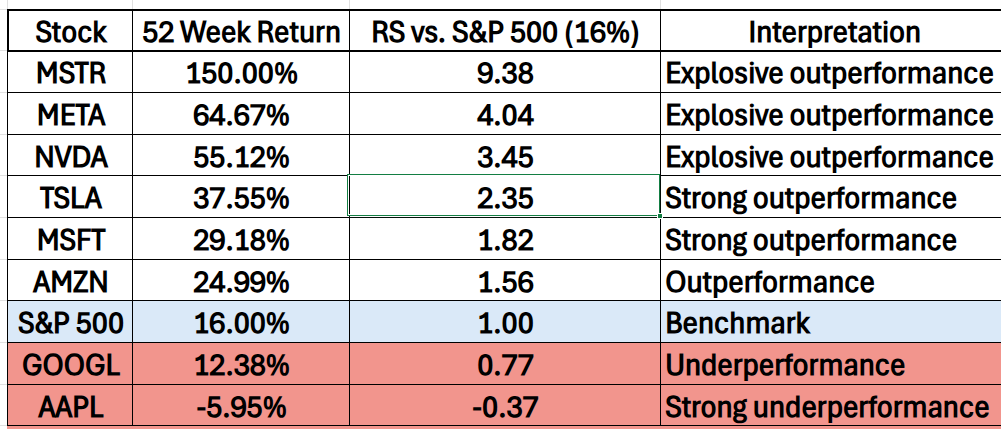
Cracks in the Mag 7 Narrative
On the surface, they’re calling it the “Magnificent 7.” But dig into the 52-week performance, and the shine starts to dull.
- Google (GOOGL): the so-called gatekeeper of online intelligence — is underperforming the market, barely scratching out a 12.38% gain while the S&P 500 delivered 16%. That’s not just underperformance — that’s a red flag waving on top of the world’s biggest advertising engine.
- Then there’s Apple (AAPL): down 5.95%. Not just lagging, bleeding. That’s a -37.19% relative strength rating, folks. Think about that. The most owned, most beloved, most defended stock on Wall Street is dead money over the past year. That’s not noise. That’s a signal.
Meanwhile, the Silent Killers Dominate
At the top of the heap? Not Meta. Not Nvidia. Not Microsoft.
It’s MicroStrategy (MSTR) with a 150% YTD gain and a 9.38 RS score — absolutely torching the rest of the Mag 7. Why?
Because while the herd is yapping about A.I. and cloud compute clusters, MSTR is making a monster bet on Bitcoin. And in a world where fiat currency is losing credibility faster than a politician in a polygraph chair, that bet is catching fire.
Pro traders? They see it. They see the real alpha isn’t in following the hype, it’s in spotting the rot in the core of the usual market leaders — and positioning in the asymmetric plays riding macro tailwinds no one wants to talk about.
Is A.I. the True Driver?
Look, you hear “A.I.” in every earnings call like it’s some divine chant. Yes, NVDA (+55.12%) is ripping. META (+64.67%) is killing it. MSFT (+29.18%) is raking in A.I. cloud revenue. A.I. spend is juicing the numbers.
But here’s the kicker:
If A.I. was truly lifting all boats, then GOOGL and AAPL wouldn’t be looking like they showed up late to the game wearing flip-flops. The fact that they’re not participating at the same level? That’s the crack in the dam. That’s where pro traders start digging.
Final Take
You want to know what’s really happening in the market? Don’t listen to the hype machine.
Study that table.
- Ask why A.I. favorites like NVDA, META, and MSFT are running hot.
- Ask why legacy giants like AAPL and GOOGL are sputtering.
- Ask why the highest flier — MSTR — isn’t even a tech company, it’s a leveraged Bitcoin proxy.
That’s not just performance data. That’s your roadmap to the truth — and where the smart money is already moving.
Want the real narrative? It’s not on the news.
It’s in the numbers — and the cracks they expose.
Let’s wrap with a truth the pros know but rarely say out loud:
Hope is not a strategy. Headlines don’t make you money. And guessing? That’s a quick way to watch your account bleed.
The traders who win consistently aren’t reacting — they’re anticipating. They’re using VantagePoint’s artificial intelligence to stack the odds in their favor, spot momentum shifts before the herd moves, and ride the strongest trends with calm, calculated precision.
VantagePoint’s A.I. isn’t some shiny gadget. It’s a battle-tested tool that scans global markets, cross-references data, and delivers high-probability signals — before the crowd catches on. It tells you where the smart money is flowing. And which stocks are showing real strength — not hype.
In a world where most traders are just guessing… this is your unfair edge.
✅ Know which sectors are heating up
✅ See the real leaders with superior relative strength
✅ Time entries with trend-aligned precision — not emotion
You don’t need to chase. You don’t need to gamble. You just need to align with the trend — and let A.I. do the heavy lifting.
If you’re serious about trading…
If you want an edge built on data, not drama…
If you’re ready to stop watching the market and start winning in it…
👉 Then join us for the Learn How To Trade with A.I. MasterClass — a fast-paced, zero-fluff online event where you’ll see exactly how today’s top traders are using A.I. to gain clarity, confidence, and control.
Because in this game, the early bird doesn’t just get the worm. It gets the whole feast.
It’s not magic.
It’s machine learning.
THERE IS A SUBSTANTIAL RISK OF LOSS ASSOCIATED WITH TRADING. ONLY RISK CAPITAL SHOULD BE USED TO TRADE. TRADING STOCKS, FUTURES, OPTIONS, FOREX, AND ETFs IS NOT SUITABLE FOR EVERYONE.IMPORTANT NOTICE!
DISCLAIMER: STOCKS, FUTURES, OPTIONS, ETFs AND CURRENCY TRADING ALL HAVE LARGE POTENTIAL REWARDS, BUT THEY ALSO HAVE LARGE POTENTIAL RISK. YOU MUST BE AWARE OF THE RISKS AND BE WILLING TO ACCEPT THEM IN ORDER TO INVEST IN THESE MARKETS. DON’T TRADE WITH MONEY YOU CAN’T AFFORD TO LOSE. THIS ARTICLE AND WEBSITE IS NEITHER A SOLICITATION NOR AN OFFER TO BUY/SELL FUTURES, OPTIONS, STOCKS, OR CURRENCIES. NO REPRESENTATION IS BEING MADE THAT ANY ACCOUNT WILL OR IS LIKELY TO ACHIEVE PROFITS OR LOSSES SIMILAR TO THOSE DISCUSSED ON THIS ARTICLE OR WEBSITE. THE PAST PERFORMANCE OF ANY TRADING SYSTEM OR METHODOLOGY IS NOT NECESSARILY INDICATIVE OF FUTURE RESULTS. CFTC RULE 4.41 – HYPOTHETICAL OR SIMULATED PERFORMANCE RESULTS HAVE CERTAIN LIMITATIONS. UNLIKE AN ACTUAL PERFORMANCE RECORD, SIMULATED RESULTS DO NOT REPRESENT ACTUAL TRADING. ALSO, SINCE THE TRADES HAVE NOT BEEN EXECUTED, THE RESULTS MAY HAVE UNDER-OR-OVER COMPENSATED FOR THE IMPACT, IF ANY, OF CERTAIN MARKET FACTORS, SUCH AS LACK OF LIQUIDITY. SIMULATED TRADING PROGRAMS IN GENERAL ARE ALSO SUBJECT TO THE FACT THAT THEY ARE DESIGNED WITH THE BENEFIT OF HINDSIGHT. NO REPRESENTATION IS BEING MADE THAT ANY ACCOUNT WILL OR IS LIKELY TO ACHIEVE PROFIT OR LOSSES SIMILAR TO THOSE SHOWN.





